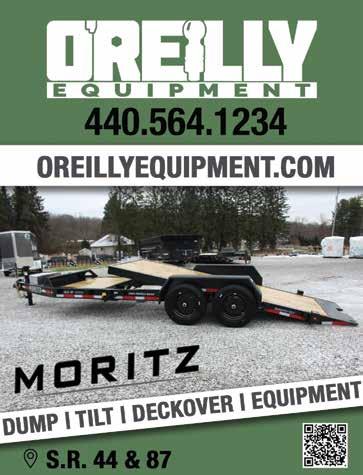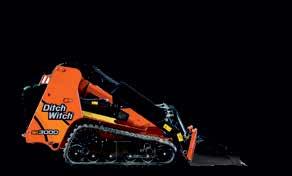TheConcernGrowing
A PUBLICATION OF THE OHIO LANDSCAPE ASSOCIATION




RYAN DRAKE
J.F.D. Landscapes, Inc.





J.F.D. Landscapes, Inc.
Spring is here and a lot of us probably feel like a one legged guy at an arse-kicking contest right about now! Mrs. Smith wanted her pansies in last week, a mower we just serviced this winter blew an engine, and there may be a small mulch fire roaring in the bin... all in addition to the backlog of work that – for many of us – might as well be Mt. Everest.
We can all relate, at some level, to these types of scenarios; none of which are ideal when piled on top of one another. To that end, we really only have one of two options to choose from when these things pop up; deal with them calmly and professionally, or lose our minds... like my 3-year-old who now doesn’t want to watch the movie she just requested five minutes ago.
While I’m not one to throw stones at glass houses (Spring has certainly pushed my grasp of sanity to its edge, a time or two), it’s easy to lose your marbles when it all seems to be coming to a head. But we are landscapers, and as such, we do the hard thing; work our butts off – dawn to dusk – in a never ending effort to make the world a better place.
While each of us chose this line of work for our own reasons (i.e., the satisfaction of seeing the results of our work immediately, the option of working outside instead of being trapped in a 10-foot cubicle, etc.), I like to think that we ALL love doing what few can do. There are not many people out there that have the skills necessary to cut a paver around a downspout so tight it looks like the paver was made in a factory for that specifically purpose, or can mow a stripe so straight across a 5-acre field that you would swear it was done with a laser. To that end, if we can learn to cut a paver and mow a straight line, we can learn how to deal with the stresses of spring. It’s not easy, but it’s also not impossible.
continued on page 6

COVER: Landscape Ohio! Awards submission in the category of Best Use of Color, submitted by Environmental Management Inc.
PRESIDENT’S COLUMN Managing Spring Stress
WELCOME NEW MEMBERS
PERENNIAL FOCUS
Polemonium: Jacob’s Ladder
FISCAL FITNESS Taxes On Investments FOR SAFETY SAKE
OSHA Top 10 Violations: Part I
PLANT OF THE MONTH
Cornus Drummondii: Giant Gray Dogwood
FEATURE ARTICLE
OHIO’S PROFESSIONAL GREEN INDUSTRY ASSOCIATION
OHIO LANDSCAPE ASSOCIATION
9240 Broadview Road
Broadview Heights, Ohio 44147
Phone: 440.717.0002
Toll Free: 1.800.335.6521
Web: www.ohiolandscapers.org and www.myohiolandscape.com
DESIGNER / EDITOR
Rick Doll
REGULAR WRITERS
Michael J. Donnellan, M3 Wealth Management
Dr. Jim Funai, PhD., Cuyahoga Community College
Shelley Funai, Stan Hywet Hall and Gardens
Ryan Drake, J.F.D. Landscapes, Inc.
Patty Lampert, Ohio Landscape Association
Bobbie Schwartz, FAPLD, Bobbie’s Green Thumb
ADVERTISING INFORMATION
Submission deadline: 10th of the month, prior to the month of magazine publication. For advertising rates and ad specs, please call 440.717.0002, or email Rick Doll Jr. at rick@ohiolandscapers.org.
Melissa Roberts 3 5 8 12
9 Keys To Leadership & Growth
FEATURE ARTICLE Doing The Right Thing Is Always The Right Thing
INDEX
DISCLAIMER
The Ohio Landscape Association, its board of directors, staff and the editor of The Growing Concern neither endorse any product(s) or attests to the validity of any statements made about products mentioned in this, past or subsequent issues of this publication. Similarly, the opinions expressed in The Growing Concern are those of the authors and do not necessarily represent the views of the Ohio Landscape Association.
OFFICERS
President Ryan Drake
President – Elect
Brandon Barker
Treasurer
Matt Malone
Immediate Past President
Cameron Maneri
DIRECTORS
Jeffrey Ardo
Jill Cline
Jason Deuble, LIC, OCNT
Amy Gatoo
Fred Krause
Tom Rieder, LIC OLA STAFF
Executive Director Patty Lampert
Associate Director
Rick Doll
Membership Coordinator


UPCOMING OLA MEETINGS, EDUCATION SEMINARS & EVENTS
APRIL 1, 2025 (CENTRAL OHIO)
CREW LEADER TRAINING (ENGLISH)
Crew leaders work side by side with employees while having to direct and motivate them. They will learn how to effectively manage their team, handle tight deadlines, all while increasing customer satisfaction.
APRIL 2, 2025 (CENTRAL OHIO)
CREW LEADER TRAINING (SPANISH)
We’re happy to announce a Spanish speaking option of this course, as part of a pilot program to determine the interest in holding spanish courses. Crew Leaders work side by side with employees while having to direct and motivate them. They will learn how to effectively manage their team, handle tight deadlines, all while increasing customer satisfaction. An English version of the course will be held on April 1st, and an ALL SPANISH version of the course will be held on April 2nd.
APRIL 2, 2025
TURF INSTALLATION CLINIC
2025
JULY 8, 2025 (CENTRAL OHIO)
PLANT I.D. CLINIC
This clinic is a hands-on training opportunity for you and your crews covering the basics of Plant ID for plants typically used in Ohio. Sponsored by Willoway Nurseries. Registration Opens May 1, 2025.
JULY 10, 2025
PLANT I.D. CLINIC
This clinic is a hands-on training opportunity for you and your crews covering the basics of Plant ID for plants typically used in Ohio. Sponsored by Davis Tree Farm & Nursery.
Registration Opens May 1, 2025.
2025
AUGUST 7, 2025
25th ANNUAL OLA GOLF CLASSIC

Artificial turf is becoming one of the most requested features by homeowners for their backyard, providing an alternative to natural grass, increased access, environmental benefits, and cost savings for communities. This clinic is a great way for you and your crews to learn more about how to incorporate it into your designs, as well as install it!
APRIL 8, 2025
IRRIGATION CLINIC
Join us at Mallard Creek Golf Club for the OLA Golf Classic! Our golf outing was created to help generate funding for our scholarship program, targeting qualified students interested in a vocation within the Green Profession. Call the OLA at 440.717.0002 for available sponsorship opportunities. Registration Opens May 1, 2025.

A hands-on training opportunity for field technicians to learn the basics of irrigation repair and troubleshooting. Participants will learn to identify the components of an irrigation system, operate and adjust irrigation controllers, and troubleshoot irrigation issues that commonly occur on job sites.
JUNE 2025
JUNE 6, 2025
28th ANNUAL AWARDS GALA
Join Ohio’s landscape community for an evening out as we reveal the 2024 Landscape Ohio! Award winners. This is a great opportunity for those of you who have been contemplating entering, or for those of you just looking to spend an elegant night out with industry leaders as we celebrate our industry! New sponsorship opportunities will be available! Call the OLA office for more info at 440.717.0002. Registration Opens May 1, 2025.
The OLA is delighted to welcome the following new members to the association:
REGULAR MEMBERS
Elite Facilities Management PO Box 96 Cardington, OH 43315 (740)812-5487
Alec Brown
ValleyScapes Designs, LLC 1304 Hunters Lake Dr E Cuyahoga Falls, OH 44221 (330)697-9474
Bryant Ausperk
S&S Landscaping & Tree Service 600 Olive Street Findlay, OH 45840 (419)421-0196
Travis Starr
Exterior Spaces Landscaping 659 Ada St. Kent, OH 44240 (440)223-7745
Matt Gilghrist
continued from page 3
Ask ChatGPT how to deal with stress and you’ll get a litany of answers. Of those, it’s important to try different techniques to see what works best for you. Some people may exercise. Others may meditate, or read. Truth be told, there’s no onesize-fits-all solution and many of us may need to incorporate multiple things to cope.
For myself, I am still on the learning journey of how to best deal with stress, so I am always interested in trying out new things. Having an open mind certainly helps, leaving the door open for new opportunities. Some days are better than others, but I believe it’s important to keep moving forward.
Outside of introducing coping mechanisms to deal with stress, my primary means of eliminating it – before it becomes an issue – is to keep my to-do lists as organized as possible, making sure each day I am focused on the priority items that I need to complete. This works great when each day goes as planned, but how often does that happen? Plans can change in a matter of minutes and dealing with those changes typically adds stress. In these instances, I suggest stepping away from the situation for a moment and giving yourself the opportunity to refocus.

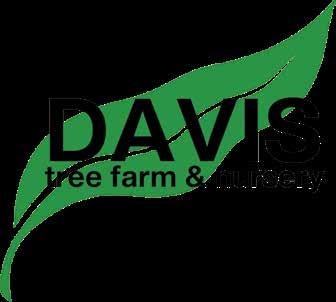


Finally, staying healthy is important for anyone, but especially for those of us who need our minds and bodies to complete our work. Getting enough sleep, proper nutrition and hydration throughout the day are essential, because when we feel good, we tend to work well. To that end, I know it’s spring, but try to resist the idea that if you just work a couple more hours tonight – after the kids go to bed – that you will have a jump start on tomorrow. In reality, this mentality only cuts into your sleep, making the next day less productive. The same goes for nutrition. Stopping at the gas station to pick up a nice rollerdog and soft drink may seem like it’s providing an energy boost, but it really doesn’t fuel us properly for the work ahead.
In closing, we can either ignore stress or deal with it. Sometimes a little stress forces us to be better as muscles only get stronger when they are under stress and it is the same for us mentally. The key is not to overdo it, because that’s when injuries and mistakes tend to occur. We need the stress to a point, but also need to know when to back off.
I hope there are a few helpful tidbits in here for making the fun of spring just a little bit less stressful and more successful!






We’ll help make your properties outstanding.
Organics are included for dense lawns without excess growth.
Weeds carefully spot treated.
Direct client billing makes it simple for you.
Landscape referrals to you.
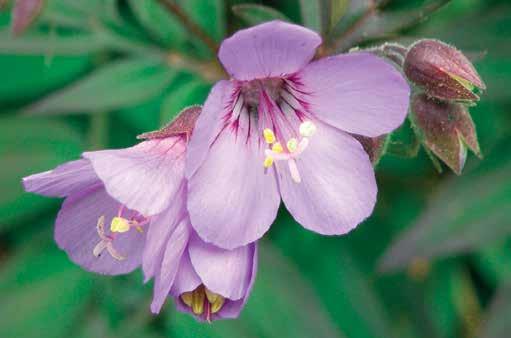

Bobbie’s Green Thumb
In all the fervor over new plants, we often forget old standbys such as Polemonium. This ferny-looking perennial supposedly thrives in full sun or partial shade as long as it receives sufficient moisture and has well-drained soil. For years, however, I tried growing it in partial shade but never really succeeded with it until I put it in full sun. It is possible that it rots in partial shade because it is too moist. Although rich soil is preferred, it should also be well-drained.
There are several different species but the one most suited to Ohio is Polemonium reptans, native to eastern North American woodlands and Midwest plains. Happily, it seems to be impervious to deer browse unlike other woodland wildflowers such as Trillium. It is also rabbit resistant. Although sometimes called Creeping Jacob’s Ladder, it is a clumper but reseeds. The weak stems never exceed 12 inches while the flower stalks can reach 18 inches. The light blue flowers appear in late April in loose, drooping clusters and become tan-colored fruits.
‘Blue Pearl’ and ‘Stairway to Heaven’ seem to be the most commonly available cultivars. ‘Stairway to Heaven’ was introduced by the New England Wildflower Society and is distinguished by its green and white to cream variegated foliage. While temperatures stay cool, the leaf edges are pale pink; then, when temperatures stay consistently warm, the variegation may disappear.
Over the years, I have tried to grow most of the species and cultivars on the market. All have died with the exception of the Brent Horvath (Intrinsic Nursery) hybrid ‘Heaven Scent’ that I grow in full sun with average moisture. It has bloomed as early as mid-May for me, continuing into June, and frequently reblooms in September. As temperatures drop in the fall, the ferny foliage, that has a slight purple cast, becomes much more purple. Sadly, no one locally is growing it but it is available from Creek Hill Nursery or Intrinsic.
continued on page 10


continued from page 8
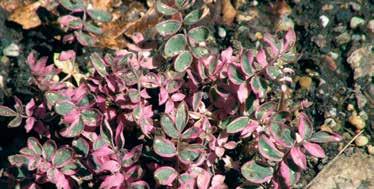


Blooming in late April, Jacob’s Ladder is a great plant for massing in the spring woodland garden. Use the ferny foliage as a foil for other types of foliage. Jacob’s Ladder is a nice complement to neighboring plants such as Arisaema triphyllum (Jack-inthe-Pulpit), Sanguinaria canadensis (Bloodroot), Trillium, and Geranium maculatum. If you are planting in full sun, you might plant the Polemonium in front of a Pinus mugo with some Euphorbia on one side and Calamintha ‘White Cloud’ on the other. Either way, give it a try.
Bobbie Schwartz, FAPLD, owner of Bobbie’s Green Thumb in Shaker Hts., Ohio, is a landscape designer, consultant, freelance writer, and lecturer whose specialties are perennial gardens and four season landscapes. In addition to being an Ohio Landscape Association (OLA) member, she is an active member of the Ohio Nursery and Landscape Association (ONLA) and Perennial Plant Association (PPA). Bobbie is a Past President of the Association of Professional Landscape Designers (APLD).










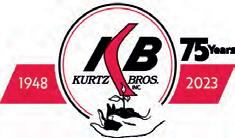


MICHAEL J. DONNELLAN M3 Wealth Management
It is that time of the year when clients have many questions regarding their tax forms and how investments are taxed. We advise clients on investments while using strategies to optimize a client’s tax situation.
Investing can be a great way to build wealth and financial security, but it’s important to understand how the sale of stocks could affect your tax bill. Here are some of the main, basic questions we encounter this time of the year…
Do I have to pay taxes on stocks?
If you sell stocks for a profit, your earnings are known as capital gains and are subject to capital gains tax.
Generally, any profit you make on the sale of an asset is taxable at either 0%, 15% or 20% if you held the shares for more than a year, or at your ordinary tax rate if you held the shares for a year or less. Any dividends you receive from a stock are also usually taxable.
If those shares are held inside an IRA, a 401(k) or other taxadvantaged account, dividends and capital gains on stock held inside that plan are tax-deferred (and tax-free in a Roth IRA).
Do you pay taxes on stocks you don’t sell?
No. Even if the value of your stocks goes up, you won’t pay taxes until you sell the stock. Once you sell a stock that’s gone up in value and you make a profit, that’s when you’ll have to pay the capital gains tax.
When the value of your stocks goes up, but you haven’t sold them, this is known as “unrealized gains.” Similarly, if the value of your stocks goes down and you haven’t sold them, this is known as “unrealized losses.” Selling a stock for profit locks in “realized gains,” which will be taxed. However, you won’t be taxed anything if you sell stock at a loss. In fact, it may even help your tax situation — this is a strategy known as tax-loss harvesting. However, if you receive dividends, you will have to pay taxes on those.
How are dividends taxed?
For tax purposes, there are two kinds of dividends: qualified
continued on page 14
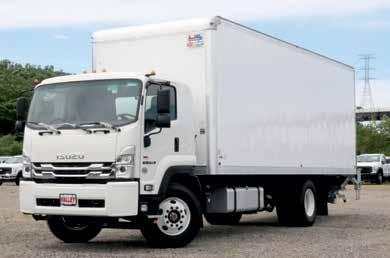


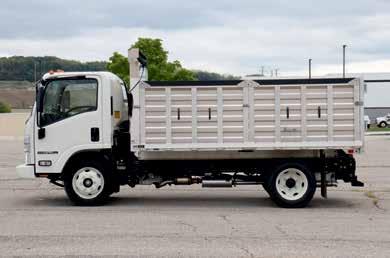

continued from page 12
and nonqualified. The tax rate on qualified dividends is 0%, 15% or 20%, depending on your taxable income and filing status. This is usually lower than the rate for nonqualified dividends. The tax rate on nonqualified dividends, sometimes called ordinary dividends, is the same as your regular income tax bracket.
• In both cases, people in higher tax brackets pay more taxes on dividends.
• How and when you own a dividend-paying investment can dramatically change the tax bill on the dividends.
• There are many exceptions and unusual scenarios with special rules; see IRS Publication 550 for the details.
Clients are always looking to avoid taxes. Avoidance is usually not plausible for the average investor. One idea to reduce taxes is to think long-term versus short-term. Holding the shares long enough for the dividends to count as qualified might reduce your tax bill. Just be sure that doing so aligns with your other investment objectives.
Whenever possible, consider holding an asset for longer than a year, so you can qualify for the long-term capital gains tax rate when you sell. That tax rate is usually lower than the short-term capital gains rate for most assets. But again, be sure that holding the investment for that long aligns with your investment goals.
Other considerations are to hold investments inside a taxdeferred or tax-advantage retirement account.
Also consider Roth IRA conversions, which accelerates tax into the current year but allows for tax-free growth over the lifetime of the account. This is great for someone in a low tax bracket now and also an investor with a longer time horizon.
As always, talk to your financial professionals and tax advisors, to determine your specific needs and goals. The information provided in this article should not be considered as tax advice. Your tax professional will understand your unique situation and offer advice specifically to your needs and goals.
Scenarios illustrated are hypothetical in nature, results may vary. Investing is subject to risk which may involve loss of principal. Past performance is not indicative of future results.
The M3 Wealth Management Office does not provide legal or tax advice. Consult an attorney or tax professional regarding your specific situation. The information herein is general and educational in nature and should not be considered legal or tax advice.
Michael J. Donnellan specializes in stock selection and retirement planning. Feel free to contact him with any questions or comments at the M3 Wealth Management office at:17601 W. 130th Street – Suite 1 in North Royalton, Ohio. Phone number (440) 652-6370 Email: donnellan@ m3wealthmanagement.com
Securities and advisory services offered through L.M. Kohn & Company. Registered Broker/Dealer - Member FINRA/SIPC/MSRB 10151 Carver Rd. Suite 100 – Cincinnati, Ohio 45242 (800) 478-0788











As a new landscaping year begins, many organizations look at ways to improve their safety programs. One way Sedgwick (OLA’s Worker’s Compensation Partner) has found effective over the years is to compare your safety program to OSHA’s Top Ten Violations List. Identifying what OSHA sees in the workplace during their inspections and comparing that to your organization is an excellent opportunity to find any gaps or deficiencies within your safety process.
OSHA publishes a top ten list every fiscal year which runs from October to September. For fiscal year 2024, OSHA identified the following on their top ten list:
1. Fall Protection (General Requirements): 6,307 violations
2. Hazard Communication: 2,888 violations
3. Ladders: 2,573 violations
4. Respiratory Protection: 2,470 violations
5. Lockout/Tagout: 2,443 violations
6. Powered Industrial Trucks: 2,248 violations
7. Fall Protection (Training Requirements): 2,050 violations
8. Scaffolding: 1,873 violations
9. PPE (Eye/Face Protection): 1,814 violations
10. Machine Guarding: 1,541 violations
Generally speaking, fall protection is required if employees work at heights 4 feet or greater in General Industry/Agriculture and 6 feet or greater for Construction. Fall protection for employees can be in the form of guardrail systems, safety net systems or personal fall arrest systems. If these fall protection options are not feasible, then an approved alternate system may be used if it meets the requirements of the standard. Fall protection is required for employees working near unprotected sides and edges, holes, excavations, ramps, runways and other walkways that meet the criteria of the specific height for that industry. The main violation OSHA is finding with this standard is failure of employers to assure proper fall protection is worn when employees are working at the heights identified for that industry.
continued on page 18

The Ohio Landscape Association – in conjunction with Botson Insurance Group - is happy to announce one of its most impactful member benefits to date, the OLA’s VIP (Value-added Insurance Protection) Program, designed exclusively for OLA members.










continued from page 16
Known as OSHA’s Right To Know standard, this regulation requires employers to inform their employees about the hazards of the chemicals they work with. OSHA violations in the workplace uncovered employers with no written hazard communication program, no list of chemicals, missing or out of date safety data sheets (SDS’s) and no employee training.
You may think ladders would not require much in the safety arena, but they show up on OSHA’s Top Ten List quite often. Ladders are not something you just set in place and climb; there are specific guidelines to follow. Violations found by OSHA during inspections include: incorrectly accessing upper landing surfaces, ladders not being used for the purpose they are designed for, using the top step of the ladder as a step, carrying objects or loads that could cause the employee to lose balance or fall and not conducting preuse inspections to ensure they are structurally sound. If your facility uses ladders, review the standard’s requirements and ensure employees follow the proper procedures.
The respiratory protection standard is essential when employees are exposed to chemicals above their Permissible Exposure Limits (PEL’s). OSHA has thousands of chemical exposure limitations and employers must ensure their employees are not overexposed to them or are properly protected. If employees are determined to be overexposed to any chemicals, employers are required to review engineering options (for example, using a ventilation system) and must implement a respiratory protection program. Citations in this standard include improper medically testing and fit testing employees so they can wear a respirator safely, no employee training on the proper use of the respirator and lack of a written program.


OSHA’s Lockout Tagout (LO/TO) Standard is important when maintenance is performed on machinery in the workplace. The main purpose is to prevent a piece of machinery’s unexpected energization (startup) while maintenance is being performed. Lockout Tagout procedures are implemented to prevent crushing injuries, amputations and even death. An effective lockout/tagout program includes developing procedures for each piece of machinery required under the standard and training and communicating those procedures to staff. In the Lockout/Tagout Standard, OSHA is finding noncompliance that includes: unwritten energy control procedures, improper training and communication, incomplete annual periodic inspections and failure to follow procedures.
Since this is intended to just be a high-level summary of the Top 5 Most Frequently Violated Standards, it is important to review the regulations thoroughly in order to achieve and maintain compliance. There are several ways to become more familiar with the regulations, including online training classes, brochures and pamphlets, reputable online sources, consulting organizations and the Bureau of Workers Compensation Division of Safety & Hygiene. Once you become familiar with each regulation, compare that to your company’s safety program and identify gaps. If you find gaps in your program or areas needing improvement, take the appropriate steps to make the changes and retrain employees if needed.
Next month, we will explore violations 6 through 10 on OSHA’s list.
This article was featured on the website SafetyByDesign.com. SafetyByDesign is a full service third party safety consulting firm specializing in laying the foundation and working with management to maintain overall effectiveness.
• Screened Topsoil (Stored in a hoop house on site.)
• Granite & Sandstone Boulders From 8” to 12’+ priced per ton and per piece on request. 1’-2’ granite and 2’-3’ granite available, presorted, for immediate pick up.
• Mixed Boulders (Available for immediate pick up.)
• Washed Gravel, Concrete & Mason Sand.
• Crushed Gravel & Limestone products available.




• Prioritize workplace flexibility. Workers prefer jobs that provide more flexibility over those that offer more vacation days. To the extent possible, give workers a say in their schedule, work conditions, work organization, work location, and work tasks.

• Match tasks to abilities. Use self-paced work, selfdirected rest breaks, and less repetitive tasks.
• Avoid prolonged, sedentary work. Prolonged, sedentary work is bad for workers at every age. Consider sit/stand workstations and walking workstations for workers who traditionally sit all day. Provide onsite physical activity opportunities or connections to low-cost community based options.

• Provide health promotion and lifestyle interventions including physical activity, healthy meal options, tobacco cessation assistance, risk factor reduction and screenings, coaching, and onsite medical care. Accommodate medical self-care in the workplace and time away for health visits.
• Cedar fences (Many styles available).
• Aluminum & Vinyl fences (In stock).
• Invest in training and building worker skills and competencies at all age levels. Help older employees adapt to new technologies, often a concern for employers and older workers.
• Several styles and colors to choose from.
• Manage hazards. Including noise, slip/trip hazards, and physical hazards – conditions that can challenge an aging workforce more.
• Proactively manage reasonable accommodations and the return-to-work process after illness or injury absences.
• Require aging workforce management skills training for supervisors. Include a focus on the most effective ways to manage a multi-generational workplace.
• Provide and design ergo-friendly work environments. Workstations, tools, floor surfaces, adjustable seating, better illumination where needed, and screens and surfaces with less glare.
• Utilize teams and teamwork strategies for agingassociated problem solving. Workers closest to the problem are often best equipped to find the fix.


This article first appeared on the The National Institute for Occupational Safety and Health’s (NIOSH) website, located at www.cdc.gov/niosh. NIOSH’s mission is to develop new knowledge in the field of occupational safety and health and to transfer that knowledge into practice. Their vision: Safer, Healthier Workers.


JIM FUNAI, PhD
Cuyahoga Community College
SHELLEY FUNAI, LIC
Stan Hywet Hall and Gardens
This month, as we continue to explore climate change ready trees, we’re sharing a beautiful, small ornamental that should absolutely be in more gardens. Cornus drummondii, or the Giant Gray Dogwood, is native to all of Western Ohio, with bands reaching into the central and northeast regions. It’s native range then extends south along the Mississippi River, spreading west into Indiana, Illinois, Iowa, Missouri, Kansas, Oklahoma, Arkansas, Louisiana and Texas.
What’s exciting about this tree is that it’s not only hardy to Zone 4 (great cold tolerance), but also happy in the hot, humid, sweaty-grossness of the South-Central states.
As a landscape plant, this native really shines, providing both beauty and habitat. Growing to 20 feet tall (slightly less in width), this plant can grow either multi-stemmed, or pruned into a single-stemmed small tree. So, depending on use and cultural management, you could consider it either a large shrub or small tree. Starting in late April, clusters of white flowers appear above the deep-green leaves and continue to show up
into early July. Most of us are familiar with both Cornus kousa (Kousa Dogwood) and Cornus florida (Flowering Dogwood) flowers. Look close at those, you will see the flowers are actually quite small and clustered in the center, with four small petals (often yellow) around four stigma and one style. In fact, what most people think is the “flower” is just four very large bracts (modified leaves) used to draw in pollinators.
Cornus drummondii flowers are like Red-twig Dogwood in that they drop the large bracts, get brighter petals, and bloom in a flat-topped cluster of many flowers together. Individual flowers continued on page 22

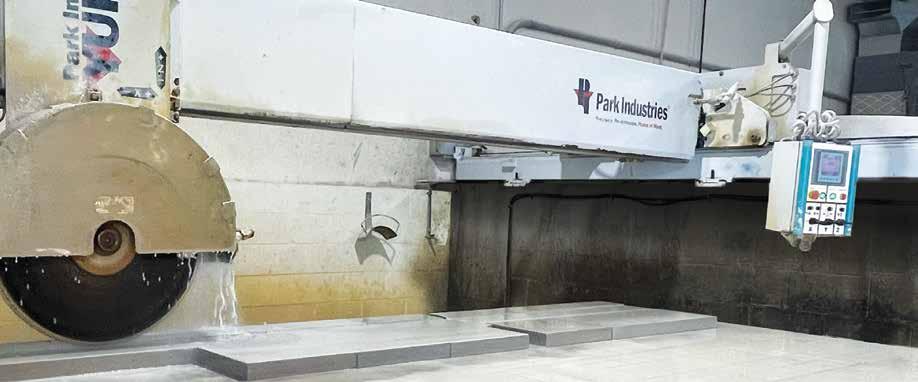

Our team has mastered the technique of stone cutting, specializing in fabricating:
• Amherst Gray Sandstone
• Amherst Buff Sandstone
• Indiana Limestone
• Briar Hill Sandstone
• Harvest Gold Sandstone
• Blue Stone & Blue Water Stone
• Travertine
... And More

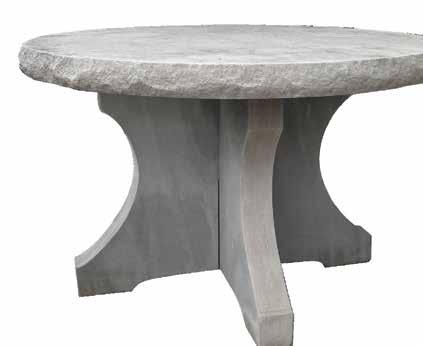


continued from page 20
are tiny and insignificant, but combined together they make a great display.
Giant Gray Dogwood’s clean, deep-green leaves, will hold strong through the rest of the summer. Starting in midAugust, fruits form as small, round, green clusters, becoming bright-white clusters through October. This means we get either a flower or fruit display for around five full months. Quite a feature for an ornamental plant!
Another notable feature of this plant is how adaptable it is. Water requirements are fairly low, but it can tolerate damper to seasonally wet soils. Through its range, you can find it in sandy to sandy-loams as well as clay-loam to full on clay soils. Sometimes, it is growing in upland sites, but also found growing right along the Mississippi River and its tributaries. The plant certainly prefers some shade, especially from the late afternoon sun.
While one of these beauties can hold its own, when grown as a tree form and used as an ornamental accent, these plants can do wonders for filling in larger spaces in your landscape – especially when planted as multi-stem large shrubs. It is a challenge to find shrubs that will fill in above the 10 foot
range and be tolerant to such a wide range of soils. Add in ornamental features that will pop from a distance (white on dark green) and you really have a background shrub doing some heavy lifting. Compare it to the millions of burning bush out there doing the same thing and you’ll see why we need to make that switch.
Perhaps you need something a little more than just the clean white flowers and fruits? Consider a beautiful introduction from local grower, Klyn Nursery, named ‘Lemon Drops’. This cultivar will achieve the same size and stature, but replaces white for soft, bright-yellow flowers and fruits. This cultivar also seems to develop slightly more consistent fall color in the burgundy/red/orange ranges, extending the ornamental timeline of this plant.
Cornus, as you know, is the genus name for Dogwoods. This plant is an example of when part of the name does not refer to some feature of the plant, but rather is named in honor of someone. In this case, the plant name honors a Scottish botanist, Thomas Drummond. Drummond had many expeditions across North America in the 1820s and ’30s. He spent a ton of time in the native range of this dogwood (described above). It isn’t clear if he first “discovered” this
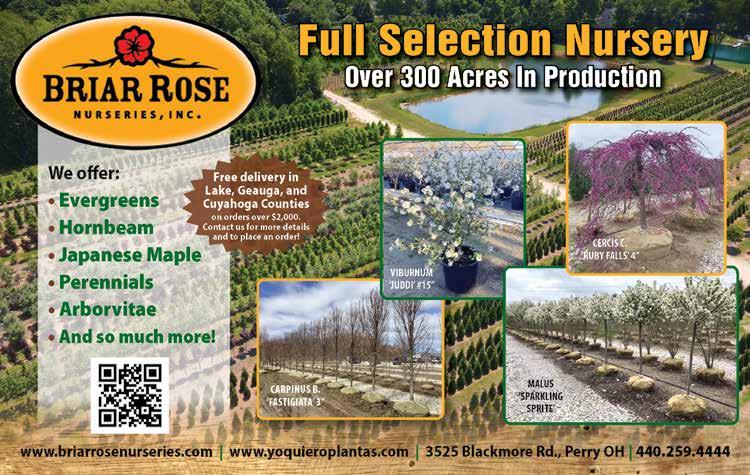
plant, or not. We put discovered in quotes because obviously the Native Americans knew of it. In fact, the fruit was used in many different natural medicines at the time.
As was common at this period in history, explorers from Europe were busy sending specimens back home to be described by Western science. There is record of one of these samples containing our plant of the month, but it wasn’t until 1845 that Carl Anton Von Mey proposed the official name of drumundii found in Drummond’s collection of 750 North American plant species sent to England.
As you encounter new landscape challenges this spring we hope you’ll consider adding the Giant Gray Dogwood to some more of your projects. You’ll be adding beauty, habitat, and most important, resiliency to your landscape!


Jim Funai, PhD, is full-time faculty at Cuyahoga Community College, a NALP accredited associate of applied science in hoticulture degree program. He has a PhD in Landscape Engineering and Forestry and is a Licensed Arborist. Shelley Funai is Grounds Manager at Stan Hywett Hall and Gardens in Akron, Ohio, which offers a historic estate designed by Warren H. Manning and a beautiful manor house museum. She is Landscape Industry Certified in Ornamental Plant Care.





From being humble to hurdling obstacles, these tips will help you guide your company better.
Ever wonder why some leaders effortlessly inspire while others struggle? The secret might be simpler than you think: Leadership, like a lush lawn, thrives where it’s nurtured.
I am often asked, “What makes a good leader?” My response is usually a bit disorganized since leading people comes naturally to me at this point in my life. Recently, during a webinar, I was forced to give my answer.
We spend so much time trying to get everything right that we sometimes forget or lose focus on what truly matters, which are the results. How many times did we think we had it all figured out, and then bam! Life sideswipes us and throws us off track, only to have another issue pop up not too long after.
I believe leadership is about staying positive and always seeking out the solution, no matter what you are faced with. My nine keys to leadership and growth are things I live by and have helped me gain followers who want to be leaders.
This key is very valuable, but you will need confidence to pull this one off and you will need to trust your audience. When you speak to people, you should always talk about your failures before you speak about your wins. No one wants to know how great you are. They want to know you are human and that they could have success just like you.
As Simon Sinek says, “Be the idiot in the room.” Along with vulnerability, not caring what people think about you is key. I’m not saying reputation isn’t important; I’m saying, don’t try to be someone you are not just to please someone else. Be your authentic self. The world needs more of you, and you must believe it.
The world didn’t need a new mower. It needed a new Lazer Z.
The Lazer Z X-Series has arrived—built to deliver unmatched durability, legendary cut quality, and performance that exceeds expectations at every turn. The future of mowing has never looked so good. Visit your dealer to experience the Lazer Z.


Explore the legacy behind the legend.

continued from page 24
To be a leader or someone of influence, don’t judge someone for what they have done or gone through. Meeting them in the hurt, if they are hurting, is key when you are trying to lead someone to a place they never thought was possible. If you only meet someone where you are, you will miss key opportunities in their growth.
To grow and be a leader, you need to tap into someone who has done it before. When you are in search of a coach or a mentor, be sure they align with your core values. I believe word of mouth is probably the best way to find a coach. Ask someone you respect in your community or in your industry if they know someone they would recommend. You might find the person you are talking to might be the coach you are looking for. I found my existing coach this way. To ease your mind, coaches will usually offer a free first meeting or call to get to know you. They want to know if you will be a good fit for them as well. If you can find alignment with a coach or mentor, the results are magical.
I heard a saying the other day, “Proactively seek meaningful discomfort.” That is the key. The discomfort needs to have
meaning so it can stretch you in the right direction. Goals are so important. If you don’t have goals, you are probably living a comfortable life, but who wants that? Set your goals to a point they may feel impossible and insert yourself into situations to obtain those goals. The situations will most often be in areas you think you are the weakest. For me, it was speaking. I wanted to be a public speaker, but I was scared to death. Still, I knew I could do it. I started by speaking to my entire company at events. That led to speaking to small groups of professionals to then getting the chance to speak on stage. I reached my goal, but I was uncomfortable throughout the process. Nothing that is great comes easy, so stretch yourself.
I believe giving back is the true meaning of life and it will give you the most joy as a leader. It’s not just about giving money; it’s about giving your gifts back to the world along with your time. Volunteer somewhere that has meaning for you. When you do, you will feel purpose.
Being a leader is about being selfless. The people you lead need to mean more than your popularity. I’ll be honest, I struggled with this one when I was young. I thought if







• Sand & Boulders
• Organic Fertilizer
• Decorative Stone
• Natural Stone - Palletized
• Ground Rubber Mulch
• Bulk Salt
• De-icing Chemicals (Bag & Bulk)
I wanted to win, I needed to be the one who crosses the finish line first. I was so wrong. When you can win over your people, that win means so much more. If my team gets an award, that’s my win. If my team can buy a home, that’s my win. Seeing the people I lead succeed is the best thing ever. I know that I created an environment for them to excel. That’s why it’s a win for me just like it is for them.
Make people laugh in stressful situations. If you can keep things light under stressful situations, you will allow your team to be able to think more clearly and be more creative. If you are a serious person and it’s hard for you to get people to laugh, pick up some old dad jokes. Dad jokes can be the best, especially if no one is expecting it from you. Now obviously, you need to read the room, but I can’t tell you how quickly you can change an environment just by adding well-thoughtout humor to a stressful situation. It’s magic.
I believe all obstacles are in our path of growth for a reason. If you figure out why the obstacle is there, you will start the process of eliminating it and growing because of it. When we have goals, obstacles are inevitable, so use them to help you. Just ask yourself, what is this teaching me? Recently,
we had an employee use our credit card for personal use. We had to let that person go, but what did it teach us as a company? How could someone make purchases and us not know for two months? It told us that our purchasing process was broken, and we need to fix it. Without that obstacle, our process would still be broken.
And there you have it. My nine keys to leadership and personal growth all in one place. Now go out and be the leader you want to be. Make a difference in someone’s life. My goal is to change 20,000 lives for good. I am currently at 65, so I hope this article will help some of you get on my list of lives changed. If I did change your life or sparked something in you, drop me a line at B.stephenson@newcastle94.com or visit me on LinkedIn or Facebook.
This article was written by Brad Stephenson, CEO of New Castle Lawn & Landscape in Pennsylvania, and was previously featured on the Lawn & Landscape Business Lessons blog, located at www.lawnandlandscape.com. Brad Stephenson is a passionate leader, entrepreneur, and certified behavioral analysis consultant dedicated to transforming lives and businesses. Lawn & Landscape magazine is your definitive source of news and business management information for landscape contractors.

The concept of “doing the right thing” came easy for me growing up on a family farm and being taught by example from my parents who put a much higher value on giving and serving than receiving monetary rewards to find happiness. Things change when I got into bigger corporate world when revenue growth and profit were always the top priorities and focus. I quickly learned what it means to do the right thing sometimes takes on a different meaning than what I was taught and how it can be used to justify actions in some of the corporate world.
Doing the right thing starts with defining your organization’s core values. Every organization should operate based on a set of values that guide its operations, interactions with stakeholders, and decision-making processes. For Choice Solutions, these core values are: Vision, Family, Greatness, Farmers Mentality, and Serve.
• Define Core Values Clearly and Concisely: Companies must ensure that their values are not part of a mission statement that is not just posted on a website, but that they are integrated into every aspect of the business. Make sure they are simple and easy to remember.
• Communicate Values Consistently: Make sure you are consistently communicating the meaning of your core values to all team members, from initial onboarding, regular training sessions, and daily use in company-wide communications. At Choice, we have a simple Slack kudos channel where team members praise other team members for their efforts, highlighting which core value that team member exhibited.
• Measure Alignment: This can include collecting employee feedback, conducting customer satisfaction surveys, and other forms of social input.
continued on page 30














continued from page 28
When you focus on building success for the long term you don’t let the pressure to win at all costs consume you, and you don’t try to sell or deliver improper solutions just to increase your bottom line. The pressure to deliver short-term results can be strong, particularly in an environment driven by quarterly earnings and performance quotas, but when you lead with what’s best for the customer, you are playing the long game by building trust.
• Invest in Employees: Companies that invest in employee development are more likely to experience long-term success. Offering learning opportunities creates a more engaged, skilled, and loyal team, leading to long-term business success.
• Customer-Centric Approach: By delivering exceptional service, understanding customer needs, and adding value, you can cultivate a base of satisfied customers and sustained growth.
Integrity is at the core of doing the right thing in business. Executives being honest, transparent, and ethical is crucial because it sets the tone for the entire organization and influences how employees, customers, and stakeholders perceive the company.
• Transparency: Foster an environment of openness by clearly communicating both challenges and successes within the company.
• Accountability: Establish a culture where accountability is a fundamental expectation, where everyone owns responsibility for their actions.
• Ethical Decision-Making: Prioritize doing the right thing alongside profitability helps ensure that business decisions are not only financially sound but also fair and just.
Ethical predicaments are inevitable in business, particularly when conflicting interests arise. Doing the right thing in these situations often means making difficult choices that may not always align with short-term profitability but are essential for maintaining the company’s integrity and reputation.
• Evaluate the Impact: It is crucial to carefully assess how decisions will affect all stakeholders. Put yourself in the other person’s shoes and ask how you would want to be treated.
• Ask this Question: If there was $10 or $1M involved would you make the same decision? The amount of money should not rationalize being right or wrong. Don’t justify decisions because of the amount of money involved.
• Stick to Principles: In challenging situations, relying on the company’s core principles and values as a guiding force is essential.
A company’s culture is a direct reflection of its leadership. For an organization to do the right thing, integrity and ethical behavior must be ingrained and lived in its culture. This culture should be evident at every level of the organization. Ownership and leaders should lead by their example. It is no good to talk the talk unless you walk the walk by your daily example.
• Lead by Example: Leadership sets the standard for the entire organization.
• Reward Ethical Behavior: Recognize and/or reward employees who uphold ethical standards, even when it involves sacrificing short-term gains.
• Provide Ethics Training: Make sure everyone understands what doing the right thing means in your organization.
Engaging with and contributing to the communities in which the company operates is another important aspect of CSR. This can include charitable donations, volunteer work, or partnerships with local organizations.
• Builds Trust: Ethical leadership builds trust with employees, customers, and stakeholders. Trust is a crucial component of long-term success in business, fostering loyalty, collaboration, and positive relationships that drive growth.
continued on page 32
















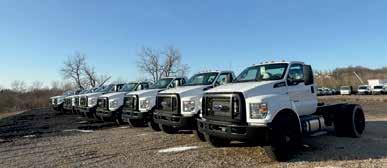

• Attracts Talent: Top talent increasingly seeks to work for companies that align with their values. Ethical leadership makes the company more attractive to potential employees, helping to attract and retain high-performing individuals who contribute to the organization’s success.
• Enhances Reputation: Companies led by ethical leaders tend to have stronger reputations. A strong reputation built on ethical practices is a significant asset in today’s competitive business environment.
Conflicts of interest are common in business, but how they are managed can define a company’s ethical standing. When conflicts arise, doing the right thing means addressing them openly and fairly or as my parents would say, “put the shoe on the other foot,” meaning treat the other party how you would want to be treated.
Marketing and communication are powerful tools in business, but they must be used ethically. Misleading advertising, exaggerated claims, and hidden terms can damage a company’s reputation and erode trust with customers and stakeholders.
While the moral imperative to do the right thing is clear, there is also a strong financial case for ethical behavior in business. Companies that prioritize ethics often outperform their peers in the long run, benefiting from increased profitability, reduced risks, and stronger customer loyalty.
One of the most significant challenges in business is balancing profit with purpose. While profitability is essential for survival, it should not come at the expense of ethics, integrity, or social responsibility. Companies that successfully balance these elements create more sustainable, resilient businesses and maintain a much less stressful working environment.
• Purpose-Driven Leadership: Leading with a clear sense of purpose that goes beyond making money is critical. This purpose should be woven into the company’s mission, vision, and strategy, guiding all business activities.
• Reporting: Communicate both financial performance and social impact to stakeholders. This approach helps build trust with stakeholders and demonstrates the company’s commitment to balancing profit with purpose.
Transparency is a cornerstone of ethical business practices. It involves being open and honest about company operations, decision-making processes, and challenges. Transparency not only builds trust but also fosters a culture of accountability within the organization. When mistakes happen, owning up to them quickly and taking corrective action is crucial.
We treasure and respect our business partners, bankers, suppliers, and vendors who play a crucial role in our company’s success. It is important you build a reputation of one they can trust as being open, honest, and transparent.
Ultimately, doing the right thing in business is about building a legacy of integrity. Executives have a responsibility to ensure that their actions today leave a lasting, positive impact for future generations. Too many companies are building to sell their companies not to build a legacy.
Leadership is often measured by financial success, but true leadership goes beyond the bottom line. It involves making decisions that reflect the company’s values, contribute to the well-being of society, and build a lasting legacy of integrity.
Leaders have the power to shape the future of their organizations. By prioritizing ethics, integrity, and social responsibility, they can create a business environment where doing the right thing is not just a “Choice” but the standard. This is the kind of leadership that will endure, inspire others, and make a meaningful difference in the world.
This article was written By Jim Steinlage, President & Chief Executive
Officer
of Choice Solutions. Choice Solutions connects businesses with the technology solutions that they need to succeed today and be prepared for tomorrow, bridging the gap between digitally transformative technologies and workplace experiences; ultimately driving productivity and profitability for their customers. Find out more at www.choicesolutions.com.





PATTY LAMPERT Executive Director / OLA
Hello Everyone,
It’s wonderful to hear the birds chirping, seeing the fuzzy buds on my magnolia tree, and knowing that spring is in the air. It is certainly going to be a busy season for all our members! As your schedule becomes crazy busy, you can continue to rely on OLA to be your resource for:
• Connectivity and creating a sense of belonging.
• Growing your business and differentiating yourself from the competition.
• Staff development to boost your bottom line.
• Improving employee retention, engagement, and advocacy.
• Building relationships and sharing ideas with other industry professionals.
• Membership event and benefit discounts.
• Pursuing your passion and making a difference in the landscape industry.
OLA is where members network, socialize, collaborate and celebrate achievements. We’re a strong community of passionate individuals coming together by common values, standards, and a commitment to create a better industry.
OLA is focused on your needs, opportunities, and challenges, and is where we gather to share challenges, shape our careers, and make a commitment to professional excellence. In your spring and summer travels, if there’s someone you would like to invite into our community, please forward them the membership QR code below for more information.

It’s truly been a pleasure meeting everyone at the OLA events. I love learning about your experiences and talking about how you and your company are doing. It’s amazing to see the OLA community come together to help others, the professional growth, and the strong camaraderie among its members. I encourage you to reach out to say hello and let me know about your experiences. I look forward to connecting with you soon and building a stronger voice together!
